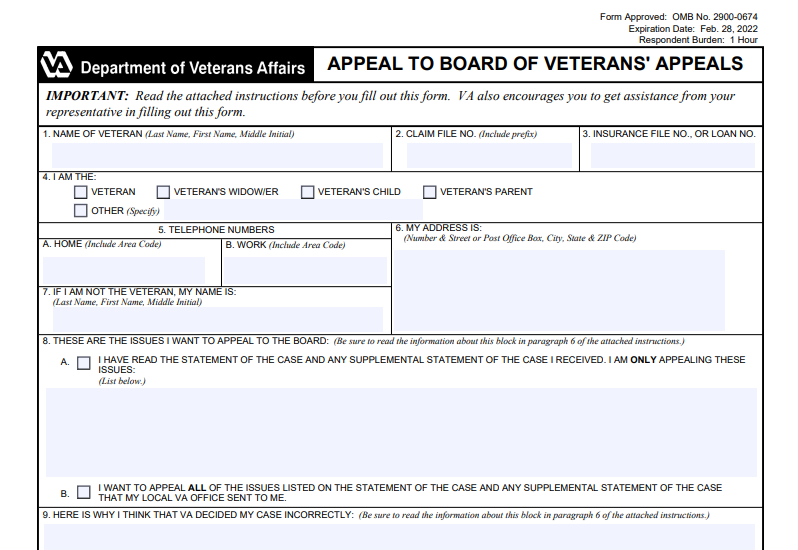Table of Contents
VA Form 9 Printable, Fillable in PDF – Appeal to Board of Veterans’ Appeals – also known as a VA Appeal Form or VA Substantive Appeal – is a legal form produced by the Department of Veterans Affairs (VA) for veterans who seek to appeal to the board after being denied VA benefits. On February 1, 2019, a new version of the VA Form 9 was issued. The most recent fillable version of the form may be downloaded here or obtained on the VA website.
If you’ve ever filed for VA benefits, you know how long it takes for a rating decision from a local Regional Office, especially if your problem is service-related. You must submit a Notice of Disagreement (NOD) with the department if you disagree with the decision. The crucial thing to remember is that you must submit a NOD within one year of the date the decision was communicated to you, not when you got it. The notification allows you the chance to explain why you believe the VA’s decision is incorrect, but you shouldn’t go into too much detail. If you go into too much detail, you can restrict your ability to appeal to merely the problems that have been raised.
The VA Form 9 Procedure
Following the submission of the NOD, you will be given the option of appealing to a decision review officer (DRO) or the Board of Veterans Appeals (BVA) (BVA). One of the following events may occur as a result of your decision:
When you seek a DRO review, the VA will ask you to give further information about the problems you want to be evaluated and to set up a hearing. If the DRO refuses your claim, they will issue you a Statement in Support of Claim (SOC), and you must complete the VA Form 9 within 60 days of receiving the SOC to pursue a formal appeal.
When you file a BVA appeal, the VA will provide you with a paper outlining the grounds for the denial of your claim. It will take a few months for the procedure to be completed. To transfer your case to the BVA, complete and submit your VA Form 9 after you get your statement of the case. Further instructions will be provided by the BVA.
A hearing with a BVA member may result in one of the following outcomes:
- Benefits sought are granted;
- The benefits sought have been refused; and
- The matter has been remanded to a local VA office.
- Instructions for VA Form 9
- Before you begin filling out the form, there are three things you should know:
What should be included? Specific arguments related to factual or legal mistakes should be included in the form. That is, the statement should include the benefits the veteran is seeking as well as details concerning the Regional Office’s judgment errors. The BVA normally sides with the veteran, although claims that lack a detailed account of the mistake may be disregarded.
Where should I put my files? The paperwork must be submitted to the Regional Office (or RO) that issued the initial decision to which the veteran is appealing.
When should you file? The form must be completed within 60 days of the day the SOC was issued, or within one year after the date, the RO mailed the veteran’s notice of the decision. If you can demonstrate a compelling cause, the deadline for filing the form may be extended. If additional evidence is provided to the RO during the appeal period and the RO issues a Supplemental Statement of the Case, you will be given a fresh 60-day window to file.
The BVA will notify you that your claim has been rejected if the time limitations are not met and not extended. Following that, you have 60 days to argue that the appeal was submitted on time and followed all of the conditions.
In addition, the VA Form 9 requires you to indicate if you want a hearing. In all, there are three sorts of hearings:
- A Travel Boarding Hearing is an in-person local hearing conducted by the Regional Office’s Veterans Law Judge.
- A hearing in Washington, D.C. – a hearing before the judge assigned to your case at the BVA in Washington.
- A videoconference hearing is when you testify through a videoconference at the local RO.
How To Complete VA Form 9
- Block 3 is left blank, but if your appeal includes an insurance claim or information about a VA home loan, here is where you should put it.
- The claimant’s information is included in blocks 4 through 7.
- Block 8 is where you mention what you’re appealing for without going into detail about why you’re appealing.
- Block 9 should be used to write out your objections to the judgment. The arguments should be relevant to Block 8’s difficulties.
- Block 10 has many options where you may indicate whether or not you wish to attend a Board hearing and, if so, where you want to go. A board hearing is fully voluntary, but it frequently lengthens the time it takes for the board to make a decision. The board will infer that you do not want a hearing if you leave the boxes blank.
- The signature of a claimant or a fiduciary is required in blocks 11 and 12. The blocks may be left blank if the document is being completed by a representative.
- Blocks 13 and 14 are reserved for the representative’s signature.
Where Should VA Form 9 Be Sent?
You’ll be told where to submit the completed, signed, and dated form together with your SOC.
